The advances made with wireless tools are some of the most exciting in our industry in a long time. Smart HVACR tools and applications like the Job Link® System App and family of tools are making work faster and smarter, while also allowing technicians to enjoy much greater precision while diagnosing and repairing a system Read more
Guest Blog

The advances made with wireless tools are some of the most exciting in our industry in a long time. Smart HVACR tools and applications like the Job Link® System App and family of tools are making work faster and smarter, while also allowing technicians to enjoy much greater precision while diagnosing and repairing a system.
Here are four ways smart tools change the game!
-
See the big picture
Since wireless tools offer seamless connections between digital manifolds, manometers, clamp meters and even scales, they allow technicians on a jobsite to see the big picture view of the system. Right from their mobile device, they see all the necessary data points to make a diagnosis—from superheat and subcooling to refrigerant pressure and more. This helps techs troubleshoot the system quickly and problem-solve with greater accuracy by bringing together disparate pieces of data to show how various adjustments impact performance.
-
There’s an app for that
The latest wireless HVACR tools, like those in the Job Link® System, work with apps on most iPhone and Android mobile devices. There’s no need for technicians to invest in a new piece of purpose-built technology to take advantage of this functionality. From the mobile device already in their pocket, techs are able to easily access information from across the jobsite while also enjoying quick reference to customer data stored in the cloud. This functionality offers greater accountability and transparency about the work being performed today and on previous service calls. Plus, Job Link is free to use!
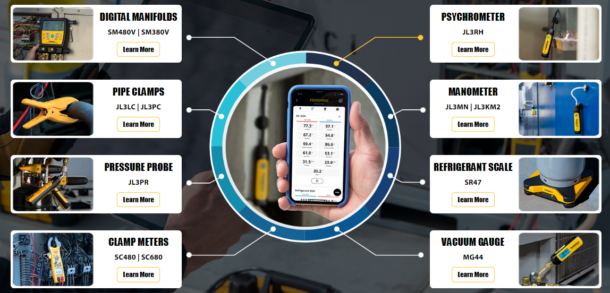
-
Put tools exactly where they’re needed
A wireless HVACR tool with a long range eliminates wasted time. Using traditional wired tools means a lot of hooking up and unhooking of a single probe or tool, making adjustments in one location and then walking back to check the reading, and so on. Also, some ideal locations for a probe could be far from an outlet or difficult to reach. Using a wireless manometer, temperature probe or pipe clamp, for example, allows the tech to choose the ideal location for a measurement. Once each tool is installed, they function independently while delivering data in real-time directly to the mobile device.
-
Lighter loads
Wireless tools not only remove the hassle of long extension cords and looking for outlets to plug them into, they also reduce the weight of the equipment that a tech needs to carry around a jobsite; not to mention, the number of trips up and down the ladder that they save.
Wireless tools help techs work smarter and faster. Pick up some of the latest innovations from Fieldpiece.

As a contracting business owner, growing your client list is essential for the success and sustainability of your company. The following seven effective strategies can help you maximize your client base and expand your reach in the industry. By implementing these time-tested techniques, you can attract more homeowners, establish your reputation, and position your business Read more
As a contracting business owner, growing your client list is essential for the success and sustainability of your company. The following seven effective strategies can help you maximize your client base and expand your reach in the industry. By implementing these time-tested techniques, you can attract more homeowners, establish your reputation, and position your business for long-term growth.

1. Build and Leverage Customer Referrals
Word-of-mouth referrals are invaluable for expanding your client list. Provide exceptional service and exceed customer expectations to encourage positive referrals.
Implement a referral program where you offer incentives or discounts to your existing clients when they refer new customers. Foster strong relationships with current clients and politely ask them to spread the word about your services. Consider reaching out to satisfied clients for testimonials to share on your website and social media platforms.
2. Network and Collaborate with Other Professionals
Networking and collaborating with professionals in related industries can lead to valuable connections and opportunities. Attend industry events, join local business organizations, and engage in online communities to meet potential clients and establish partnerships.
Build relationships with architects, interior designers, real estate agents, and other professionals who can refer clients to your contracting business. Collaborate on projects and cross-promote each other’s services to expand your reach into new circles and attract additional clients.
3. Offer Exceptional Customer Service
Providing exceptional customer service is crucial for client retention and acquiring new customers through positive reviews and recommendations. Respond promptly to inquiries, be transparent about project timelines and costs, and keep clients updated throughout the process.
Listen to their needs, promptly address concerns, and strive to exceed their expectations. Going the extra mile for customers and delivering outstanding service sets you apart from competitors and encourages clients to refer you to others. Focus on building long-lasting relationships with your clients based on trust and satisfaction.
4. Implement Targeted Marketing Strategies
Develop targeted marketing strategies to reach potential clients actively seeking contracting services. Identify your target audience based on demographics, location, and specific needs. Utilize online advertising platforms like Google Ads and social media advertising to display your services to relevant audiences.
Consider creating informative content, such as blog posts or videos that address common questions or problems homeowners face. Share this useful, customer-focused content on your website, social media channels, and relevant online forums to establish yourself as an industry expert and attract potential clients.
5. Utilize Social Media Platforms
Leverage the power of social media to expand your client list. Create profiles on popular platforms like Facebook, Instagram, and LinkedIn to showcase your work, share testimonials, and engage with your audience. Post regularly, providing helpful tips, before-and-after project photos, and updates about ongoing projects.
Encourage clients to follow and share your social media content to increase your reach. Consider running some targeted ad campaigns on social media to reach a wider customer audience and generate leads for your contracting business.
6. Enhance Your Online Presence
To grow your contracting business’s client list, it is crucial to establish a strong online presence. Create a professional, user-friendly website to showcase your services, post useful information, share customer testimonials and past projects, and list your contact information. Optimize your website with relevant keywords such as “Lakeway roofing” if your business provides roofing services in Lakeway to improve its visibility in search engine results.
Additionally, claim your business profiles on popular review sites and directories to increase your online visibility and credibility. Use search engine optimization (SEO) strategies to rank higher in search results and attract potential clients.
7. Focus on Positive Online Reputation Management
Maintaining a positive online reputation is crucial for attracting new clients. Monitor online reviews and respond promptly and professionally to positive and negative feedback. Encourage satisfied clients to leave reviews on platforms like Google My Business, Yelp, and industry-specific directories. Address negative feedback by offering solutions or rectifying the situation to demonstrate your commitment to customer satisfaction.
Regularly monitor your online presence and address any false information or negative content that may harm your reputation. Positive online reviews and a strong reputation will attract new clients and build trust in your contracting business.
8. Joining Multinational Manufacturers in Mexicali
Mexicali has quickly emerged as an industrial hub, drawing many multinational manufacturers. Establishing operations here allows you to take advantage of its prime geographic location, highly trained labor force, and attractive trade agreements. Collaboration with existing manufacturers may open doors to beneficial partnerships, knowledge sharing opportunities, increased market presence and an expanded customer reach. Observing local regulations while contributing positively to community can pave the way for long-term business success and growth prospects. Find out how you can join the multinational manufacturers operating in Mexicali.
Final Thoughts
Consistently implementing these strategies and adapting to the evolving needs of your clients will help your contracting business grow its client list and thrive in the competitive market. Stay committed to delivering quality work and continuously improving your services to ensure customer satisfaction and maintain a thriving contracting business. Maintain consistent marketing efforts while attracting new clients and positioning your business for long-term success.

Key Performance Indicators (KPIs) can be a very valuable measurement tool for the overall health and success of your business when tracked and interpreted correctly. Because businesses are only as successful as their employees, it’s imperative for owners and managers to set a standard of KPIs and follow through on measuring their progress. Doing so Read more
Key Performance Indicators (KPIs) can be a very valuable measurement tool for the overall health and success of your business when tracked and interpreted correctly. Because businesses are only as successful as their employees, it’s imperative for owners and managers to set a standard of KPIs and follow through on measuring their progress. Doing so will help you foster more employee satisfaction and ensure more customer satisfaction as well.
In the home service world, there are many different types of important KPIs. Let’s focus on a few of the top ones you can use to track customer service teams and technicians. The lists below are focused on areas that will help your business increase average ticket size and revenue. Once tracking, you may be able to identify areas where more training or strategic staffing will benefit you most.
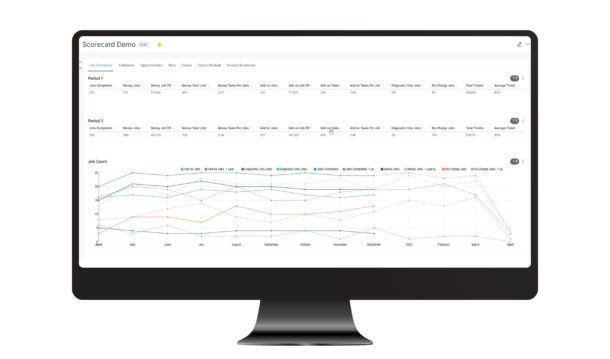
Customer Service Team
As the first interaction a customer or potential customer will have with your business, your Customer Service Representatives (CSRs) must provide the best possible customer experience. When your customers have an excellent experience right from the start, it typically pays off in increased revenue and customer retention. A few KPIs to track:
- Average Response Time – Track how long it takes your CSRs to answer a customer inquiry. Whether by phone call, email, or text, you don’t want to keep your customers waiting a long time to hear from you. If the average response time is getting longer each month, you may want to add another CSR to lighten the workload.
- Customer Satisfaction – Through surveys, feedback forms, or ratings, you can solicit feedback from your customers on how satisfied they are with the experience they had with your CSR. The higher the score, the happier your customers are with your customer experience and the more likely they will recommend your business to a friend or return for repeat business.
- Booked Jobs Conversion Rate – When your CSRs are scheduling a high number of jobs that result in completed, revenue-generating jobs, you have increased revenue and profit. By tracking this performance, you can make informed scheduling decisions that will get your CSRs with the highest booked jobs ratio working during busy times or in an active queue. If you have a CSR who books jobs that are constantly canceled, you can investigate why this is happening.
- Upsell Rate – This metric will tell you how successful your CSRs are at upselling your customers on products, services, or agreements to increase your average ticket size. Track how adept your CSRs are at this and offer training in the art of the upsell; it’s time and effort that should pay off quickly.
Technicians
Optimizing technician performance out in the field is key to making sure customers are happy and strategic goals are being hit or exceeded. A few KPIs to track for technicians include:
- Average Length of Repair Time – the rate at which your technicians are able to complete jobs will directly affect the number of jobs done in a day and amount of revenue you make. Once you start tracking, you may be able to identify technicians who would benefit from additional training so they can maximize their daily number of jobs and you can maximize profits.
- Number of Callbacks – When your technicians have to go back out to a completed job to address an issue, it takes up valuable time that could have been spent on a revenue-producing job. Once you start tracking this metric, you will get a sense over time if there are any trends with your callbacks, such as high numbers from one technician or from a particular piece of equipment. Having that insight gives you the opportunity to offer additional training that will address any repetitive issues.
- Average Ticket Size – Upselling can have a huge impact on your profits, but it’s not a skill set everyone has. The key is knowing which of your technicians have those strengths – the ones with a large average ticket size – and scheduling them for specific jobs where they may have the potential to sell a homeowner on upgraded equipment, for example. You could even incentivize your techs to sell more by starting a contest to see who can increase their average ticket size or have the largest ticket size. The prize is two-fold – for the winning employee and for your business.
- Total Number of Opportunities Identified in the Field – Technicians are your front line for identifying future job opportunities. What they notice at your customer’s home – such as potential repair or replacement issues – can give your sales team something to follow up on. Tracking how many opportunities each of your techs are bringing in is important. These are great revenue generators for customers already familiar with your business and how you work.
These are just a few ideas of top KPIs you can start tracking to measure success with your CSRs and technicians. Make sure your business management software is giving you insight into these valuable metrics to help you make data-driven decisions regarding your business.
 Paul Carmody has over 20 years of experience as a senior executive in Software-as-a-Service, technology-enabled services, internet infrastructure, and supply chain/manufacturing industries. He has served as a key executive in five successful exits and one IPO. He is currently President of Successware, an Authority Brands company.
Paul Carmody has over 20 years of experience as a senior executive in Software-as-a-Service, technology-enabled services, internet infrastructure, and supply chain/manufacturing industries. He has served as a key executive in five successful exits and one IPO. He is currently President of Successware, an Authority Brands company.
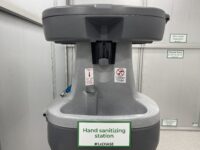
By Steve Corletta, Project Executive with LeChase Construction Services, LLC Preventing the spread of infections has always been a priority for hospitals and healthcare centers, but that mission has come into sharper focus in recent years with the emergence of COVID-19. A hospital’s strategy for preventing the spread of disease is a thorough regimen of Read more
By Steve Corletta, Project Executive with LeChase Construction Services, LLC
Preventing the spread of infections has always been a priority for hospitals and healthcare centers, but that mission has come into sharper focus in recent years with the emergence of COVID-19.
A hospital’s strategy for preventing the spread of disease is a thorough regimen of disinfection and hygiene that includes scrubbing, wearing gloves and masks and diligently sterilizing equipment. But it starts with operating in a space that helps contain infections.
At LeChase, our extensive experience in hospital and healthcare construction has shown that a hospital’s construction partner plays a key role in containing infections, notably airborne germs. A well-constructed building is the stage on which infection–control measures take place. Airtight seals and negative air pressure in key rooms – and now in more rooms than before – ensure that air moves inward and prevent airborne germs from escaping into a corridor or adjoining room.
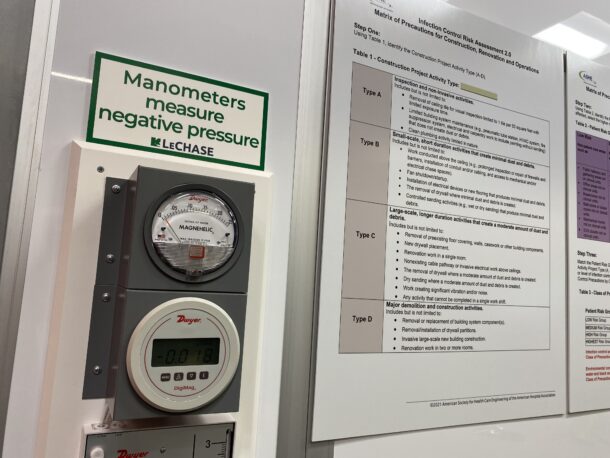
Historically, one or two rooms in a hospital wing of 20 rooms were specially built to contain infections. While that may have been sufficient when hospitals were concerned with breakouts that were less rampant, COVID-19 changed the equation. The fast-spreading pandemic showed that more such rooms were needed. Indeed, hospitals need to be prepared to isolate everyone in a wing.
This means more seals that need to be reliably airtight and more dedicated equipment for each room.
To meet the higher level of protection, LeChase applies the deeply ingrained understanding of quality control we have developed over many hospital construction projects. We also remain mindful of the hospitals’ costs, which can rise substantially with the higher capability to isolate patients. LeChase, a leading builder of healthcare facilities, applies its purchasing power and expertise to keep costs down.
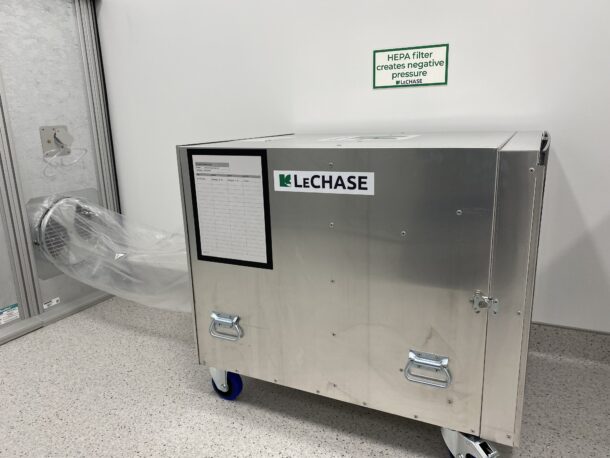
We demonstrated our dedication to infection control and efficient, high-quality construction at the University of Rochester, where we recently installed one of Synergy Med’s Clean Cube operating rooms in the recently-completed surgical center at the Center for Orthopaedics and Physical Performance. The prefabricated, pre-engineered room is the world’s first fully functioning, technologically complete smart-cube of its kind in an academic institution.
The unit includes a built-in, automated system that provides continuous 99.9 percent disinfection. Its glass walls are more hygienic, non-porous and easily cleaned than drywall or stainless steel and offer the ability to hermetically seal the space.
LeChase’s dedication to controlling the spread of infection begins with its own operations. In late 2021, the company took a major step forward in providing less disruptive, cleaner construction operations with the opening of its Infection Control Risk Assessment (ICRA) Center. The center trains crews to prevent dust and other contaminants from spreading from its construction projects – including hospital renovations and expansions that often take place near areas where medical personnel are treating patients.
Located at the company’s New York Metro office in Armonk, it was among the first ICRA centers developed by a private company in the country. By training construction staff to prevent the spread of dust and other contaminants, it plays an effective role in containing infections. As the Centers for the Disease Control and Prevention notes on its website; “Airborne transmission can occur when infected patients cough, talk, or sneeze germs into the air (example: TB or measles), or when germs are aerosolized by medical equipment or by dust from a construction zone.”
Construction companies who serve hospitals and healthcare facilities must commit themselves to being innovative and staying abreast of the latest developments in infection control. As key partners in helping prevent the spread of disease, the companies and their crews shoulder the responsibility of helping to prevent outbreaks, stem the spread of diseases already impacting a community, and even mitigate the impact of a pandemic.
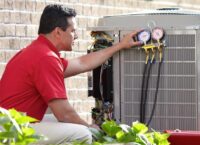
Every day, it seems HVACR systems are evolving to work with new refrigerants, use less energy, and take advantage of new innovations. Since many customers want to use the best technology to heat and cool their homes and offices, staying up to date on these changes is crucial. Market shifts also change the way that Read more
Every day, it seems HVACR systems are evolving to work with new refrigerants, use less energy, and take advantage of new innovations. Since many customers want to use the best technology to heat and cool their homes and offices, staying up to date on these changes is crucial.
Market shifts also change the way that diagnostic tools are utilized. Staying up-to-date on both the latest HVACR systems as well as the tools used to diagnose and repair them has never been more important. Here are three ways that HVACR professionals can expand their knowledge and stay ahead of the curve.
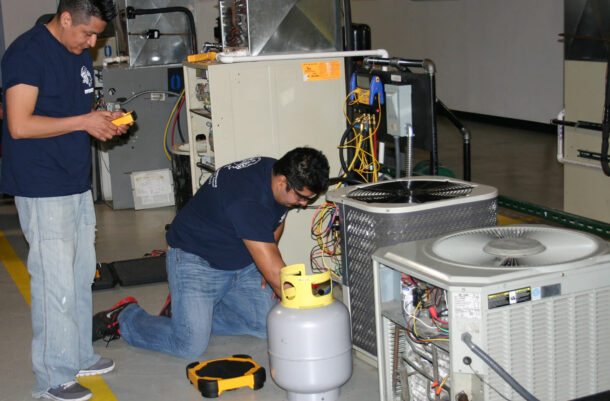
1. Stay Sharp
Continuing education can help a tech stay in the know and prepared for industry changes. Leveraging online tutorials, podcasts, videos, HVACR training meetings and conferences can help techs to learn the latest trends, stay current on emerging technologies, and utilize existing tools in the best ways possible. One such place is Fieldpiece University. This online resource was created to help HVACR technicians boost their skills and learn more about Fieldpiece products. These courses explore how each product benefits customers and offer Pro Tips for using them correctly in the field. This is an ideal tool for any HVACR professional looking to get the most from the tools they work with every day to get better, faster, and easier.
2. Help others
Learning on the job is another way to grow. Try volunteering with local charities or churches for pro bono work and for neighbors in need. Helping a family maintain an older furnace through the winter is a great way to gain experience on a legacy system. In an ever-changing landscape of HVACR technology, familiarity with a range of systems both old and new is yet another important tool in a tech’s bag. And helping your friends and neighbors adds an extra sense of accomplishment after a long day in the field.
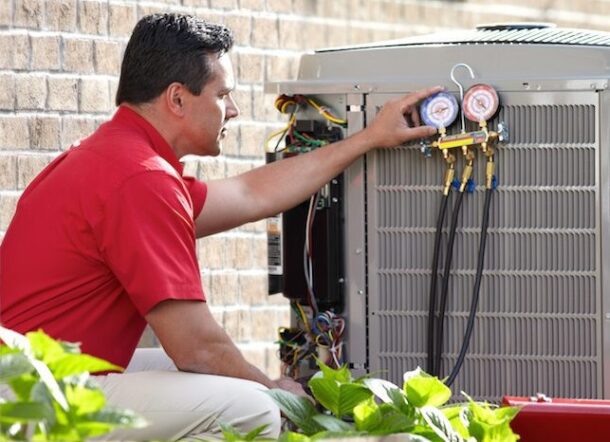
3. Leverage your senses
Before a tech opens their tool bag and starts running diagnostic tests, it’s important to know what needs fixing. Start by asking questions and really listening. Then use your eyes and touch to verify and pinpoint potential sources of those answers. The customer doesn’t need to be an expert in HVACR to answer. Questions about symptoms they can see and feel in their spaces may lead to finding the problem. Letting the customer speak typically points in the direction of the real reason for the call. The more useful information that’s gathered up front, the easier it can be to find the true cause of the issue. This may lead to a standard service, maintenance or even a system upgrade. Leveraging your ears, eyes, and touch will identify a whole host of potential issues and solutions and help ensure the right solution is put into place.
If you’re looking to be a better HVACR tech tomorrow, start learning, helping and listening TODAY. For more information about HVAC, check out Fieldpiece.
